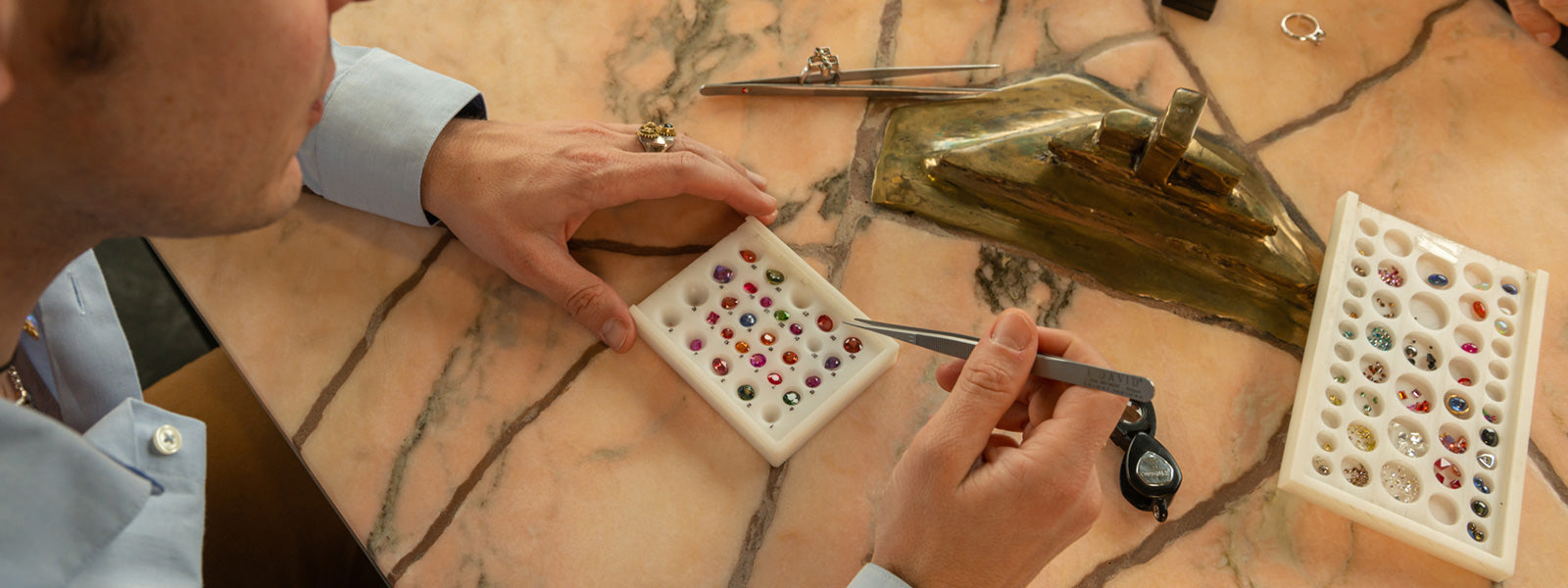GEMMOLOGY WORKSHOPS
La Maison Tournaire propose des ateliers d’initiation à la gemmologie (l’étude des pierres précieuses). Grâce à leur passion pour les pierres, nos experts gemmologues vous feront vivre ces ateliers qui permettent de déceler les secrets des pierres précieuses et de découvrir la Maison et ses bijoux sous un autre angle.
ATELIER GEMMOLOGIE EN 3 GRANDES PARTIES
Découvrez l’univers fascinant de la joaillerie et de la gemmologie grâce à un atelier unique proposé par la Maison Tournaire dans les boutiques de Montbrison, Lyon ou Paris . Divisé en trois grandes étapes, cet atelier allie théorie, découverte et immersion dans les créations iconiques de la Maison, pour une expérience à la fois enrichissante et conviviale.
- La première est plus théorique et permet d’acquérir les connaissances de base et le vocabulaire nécessaire à la compréhension de l’atelier.
- La deuxième partie est consacrée à la découverte des pierres précieuses. La Maison Tournaire n’hésite pas à casser les préjugés que l’on peut avoir sur ces dernières. Vous tiendrez entre vos mains les pierres les plus précieuses comme des diamants, Saphirs, Opales, Tanzanites… Vous pourrez les observer grâce aux outils de gemmologue.
- La dernière partie permet aux participants d’avoir un contact direct avec les créations de la Maison Tournaire car elle est dédiée à leur présentation. Entre bijoux iconiques comme la bague Trilogie Alchimie ou les bagues French Kiss mais aussi les bijoux plus intrigants comme les bagues Marélie carambole, vous découvrirez l’esprit de la Maison et ses valeurs grâce à nos experts gemmologues.
Vous pouvez contacter votre boutique Tournaire la plus proche pour plus d’informations.

SUCCOMBEZ À LA BEAUTÉ DES PIERRES
Our gemology workshop allows participants to discover the science of stones, their meaning and how a jeweler handles and observes them. It also gives you another way of discovering the Maison Tournaire and its unique creations, which you will have the chance to handle during this gemology workshop.
La vision de la Maison Tournaire sur les pierres et les bijoux
La Maison Tournaire utilise les pierres précieuses pour concevoir des bijoux d'exception aux charmes intemporels. Philippe et Mathieu Tournaire façonnent et créent des bijoux avec finesse et élégance grâce au savoir-faire unique de joaillerie.
Pour la Maison Tournaire, chaque bijou raconte une histoire, et chaque pierre est sélectionnée avec soin pour incarner une émotion ou un souvenir. Les pierres naturelles, avec leur éclat unique, transcendent leur statut de simples matériaux entre nos mains, devenant de véritables œuvres porteuses de sens. Cependant, leur véritable valeur dépasse leur prix : elle réside dans l’émotion qu’elles suscitent. Bien que le prix soit souvent lié à la rareté, cette notion reste relative. À une époque, les coquillages étaient très prisés par ceux vivant loin des côtes, car leur acquisition était difficile.
Chez la Maison Tournaire, chaque bijou est conçu pour sublimer la pierre qui l’accompagne tout en la protégeant. Lorsqu’une gemme est fragile, un design adapté est indispensable, car chaque détail compte. Comme le disait Philippe Tournaire : « Mieux vaut une petite pierre sublime qu’une grande sans âme.”
Le choix des pierres : une démarche du cœur
Pour choisir une pierre, nous ne nous contentons pas de son apparence. Au sein de la Maison Tournaire, c’est le cœur qui parle. Une pierre doit vibrer, sa couleur doit « pétiller » et captiver, c’est l’effet qu’elle produit qui guide les choix de la Maison.
Avant de vous présenter les gemmes qui composent ce que nous appelons notre « palette de couleurs », il est essentiel de comprendre leur diversité :
- Les pierres naturelles, trouvées dans la nature, uniques par leur formation.
- Les pierres synthétiques, fabriquées par l’homme mais possédant les mêmes propriétés que les naturelles, comme le saphir synthétique.
- Les pierres d’imitation, qui imitent l’apparence des pierres précieuses mais sans en partager les caractéristiques physiques ou chimiques, comme l’oxyde de zirconium pour le diamant.

Les critères essentiels : dureté, poids et pureté
Le choix d’une pierre en joaillerie repose sur trois critères essentiels.
D’abord, la dureté. Elle est mesurée grâce à l’échelle de Mohs, qui va de 1 pour les matériaux les plus tendres à 10 pour les plus durs. Une pierre trop tendre, avec une dureté inférieure à 7, risque de s’abîmer avec le temps.
Ensuite, le poids. Exprimé en carats, où un carat équivaut à 0,2 gramme, il influence à la fois l’apparence et la valeur de la pierre.
Les 4C sont les quatre critères à prendre en compte lorsque l’on choisit une pierre. Ces critères sont,
en anglais : Carat, Color, Clarity et Cut, ou en français Carat, Couleur, Pureté et Taille. Bien que
principalement utilisé pour le diamant, les 4C peuvent également être appliqué, dans une certaine
mesure, à toutes les autres pierres.
The guarantee of uncompromising craftsmanship
OUR TITLES AND LABELS










